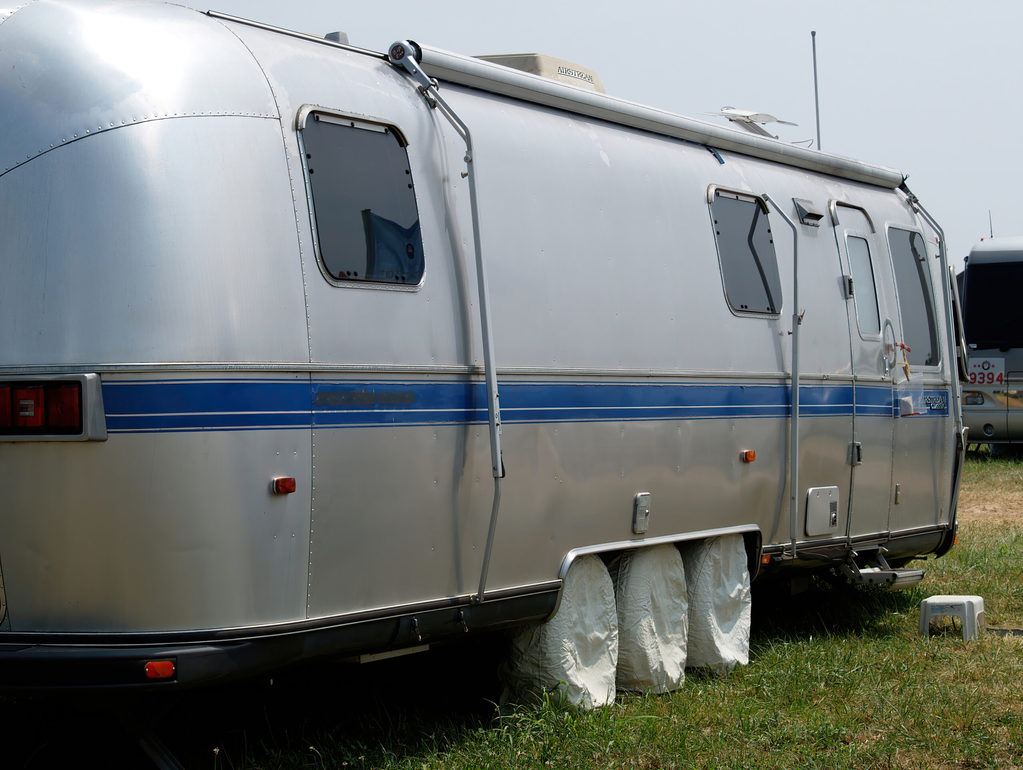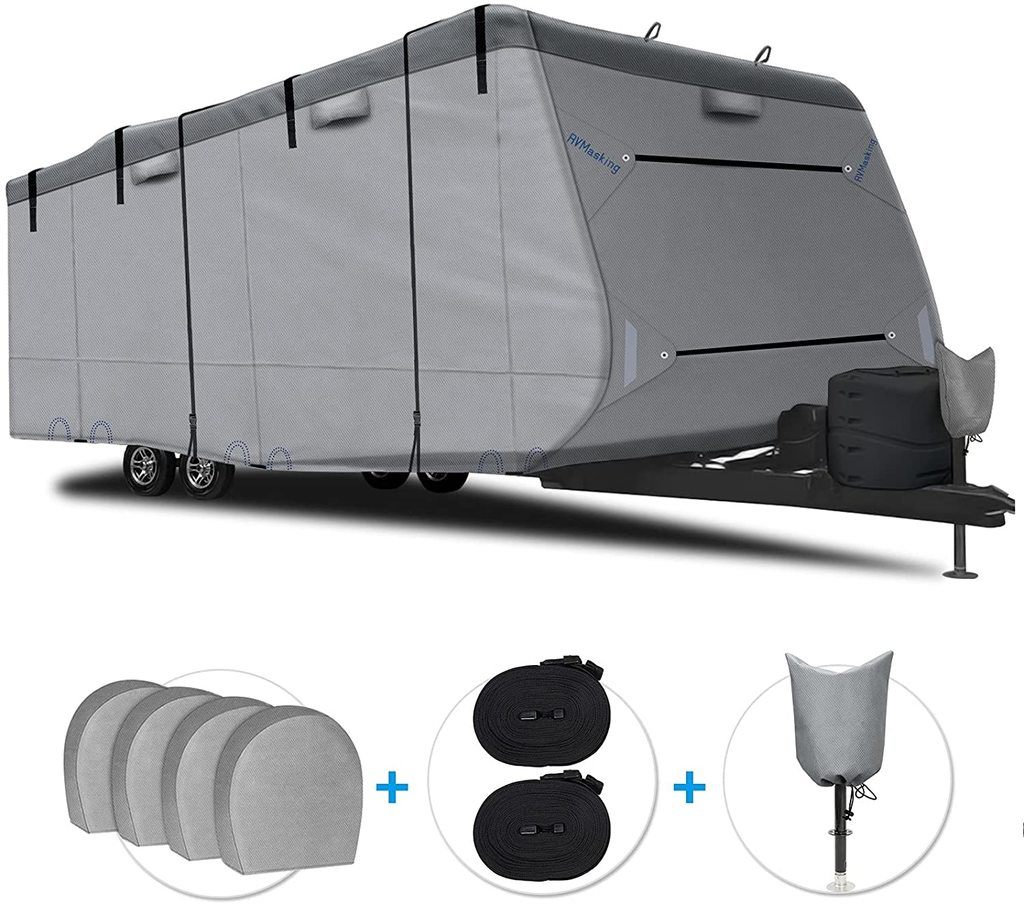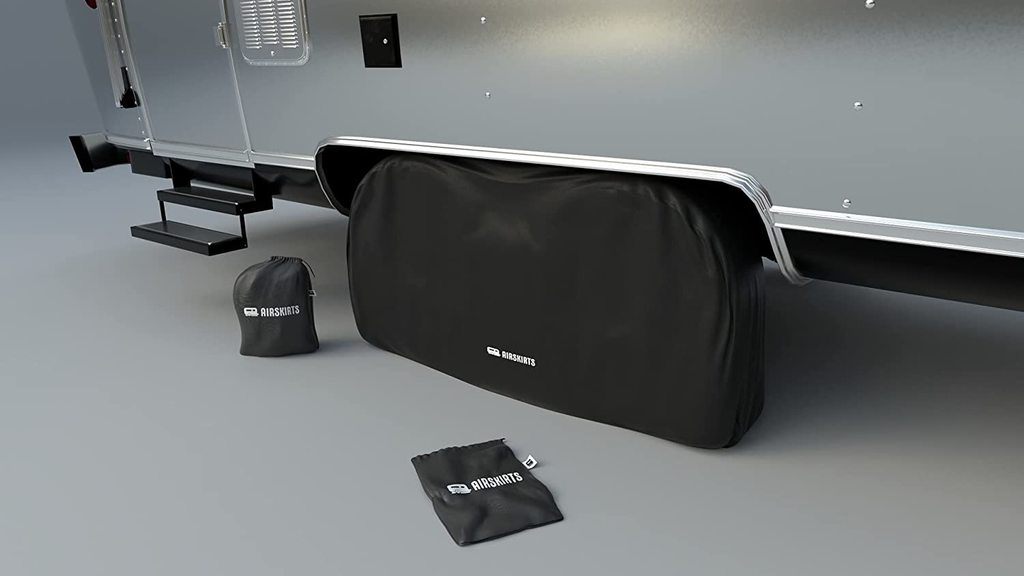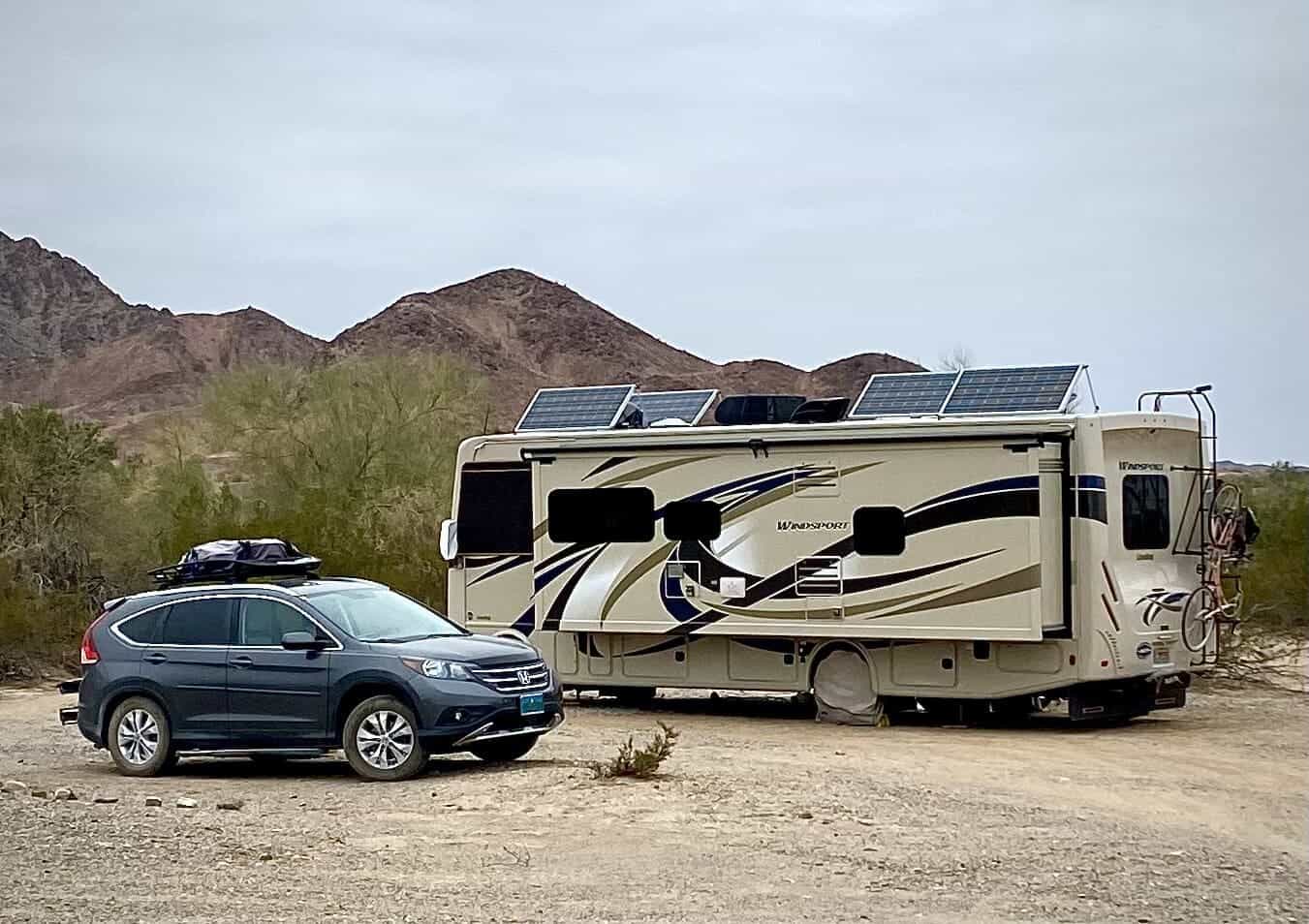Are RV tire covers necessary? Or is that salesperson just trying to make a buck? Let’s examine RV tire covers pros and cons. This article explains:

Why Camper Tires Deteriorate
According to Popular Mechanics, camper tires deteriorate for three reasons.
- UV sunlight
- ozone
- road chemicals
Many RVs sit for months in direct sunlight. Over time, UV sunlight and ozone leaves the gel coat on RV exteriors looking clouded and flat. Anyone who tries to sell a used RV quickly discovers that RV gel coat deterioration lowers RV resale value by thousands of dollars. RV tires deteriorate in a similar way, only your life is at risk when it happens. Over time, UV sunlight and ozone causes RV tires to slowly decompose, crack, and become dangerous on the road. The good news is you can do something about it.
The Worst and Best Ways to Protect RV Tires
Automotive tires bear the brunt of a vehicle’s wear and tear. Cheap or expensive, tires are made with UV protection in mind. That’s why they’re always black. The black rubber coloring isn’t just for looks. RV tires are made with a rubber blend recipe that turns rubber into a carbon black material. Carbon black absorbs heat of the sun, and UV rays. This tire material is the best way to protect tires from sunlight.
Knowing the ins and outs of RV tire safety and care is crucial for your safety.. The better you care for RV tires, the longer they last and the least you have to spend replacing them.
Petroleum and alcohol-based tire conditioners are the worst
Tire manufacturers like Michelin add substances like waxes and emollients to the rubber during the manufacturing process. These materials slow down car and RV tire deterioration. The best way to keep your tire in shape is avoiding alcohol and petroleum-based tire cleaning products. They might make your tires look nice, but at a cost.
Avoid the use of petroleum based tire cleaning products as they can exhaust the tire’s oxidation and weathering agents within the rubber compounds, resulting in cracking. Use only non-petroleum based products or plain soap and water for tire cleaning.
Michelin Tire Care and Maintenance
Use only petroleum and alcohol-free tire cleaners approved by your RV tire manufacturer.
DIY RV tire covers are better protectors, but not great
Whether DIY or store-bought, camper tire covers are a good way to prevent UV sunlight and ozone RV tire damage. Many RVers make their own cheap DIY RV tire covers with tarps.
For purely economic reasons I make cheap DIY RV tire covers with tarps too. Tarps wear out after a few seasons, but the cost to replace them is reasonable.
The Pros of DIY RV Tire Covers
- Tarps are cheap, and tough enough to handle wind or snow shoveling around my RV, with care.
- They’re easy to install. Just get the tarp over each set of tires, and secure with bungee cords.
- You can find tarps at any hardware store.
The Cons of DIY RV Tire Covers
- Tarps are rough, and may scratch your RV exterior.
- Bungees may cause marking on the RV siding or fenders if allowed to rub.
- Under normal use tarps may last up to about 3 years before the ultra violet rays make them brittle and leaky.
Some DIY RV tire covers are better than others
If you are good at sewing, here’s a great tutorial to make DIY RV tire covers. You will need these materials:
- Tape measure
- Heavy duty sewing machine
- Industrial outdoor fabric
- Hot knife
- Hook and loop fastener
Follow along in the video to make your own tire covers for a trailer or other RV.
Store Bought RV Tire Cover Pros and Cons
You have a few options for store bought RV tire covers, with pros and cons that come with each. From wheel covers to giant RV covers, your only limitation is your budget.
RV Covers Protect RV Tires, Too
A number of companies manufacture tailor-made RV covers. These giant blankets encase the whole RV from front to back, and top to bottom. Most have a soft lining to protect RV exteriors from chaffing and rubbing damage when the cover blows in the wind. The outer layer of RV covers usually includes a material designed to repel water and snow. Many RV covers have a hook and loop fastener or zipper entrance that lets you get inside the RV after the cover is installed.

When you buy an RV cover the entire RV is protected from UV sunlight damage both inside and out. RV covers are the best way to protect RV tires and everything that sits on them.
Prices for universal fit RV covers range from around $100 to around $500.
Basically you get what you pay for. The lower end covers are less likely to last as long as the higher price models. There are many sources for covers, here are a few:
RV Cover Pros
- RV covers are tailored to fit your RV within a reasonable tolerance.
- Well-made, properly installed RV covers don’t whip in the wind as much.
- These covers are lined to prevent chaffing.
- RV covers protect the entire rig, including RV tires. Any bungees used to secure them will be below the exterior finish, or on the outside of the cover. Less chance for marring of the exterior.
- Most RV covers provide access to the RV when covered.
RV Cover Cons
- You will spend more money. RV covers cost as much as 20 times more than a tarp.
- Cheap RV covers may not last longer than a tarp.
- Installing RV covers takes more effort than covering RV tires with a tarp. Tailored corners require a square and true installation, or the cover may not fit.
My opinion is that it you live in the snow-belt, the added expense of a tailored RV cover is impractical. They just don’t hold up well enough to justify the expense. If you are in the south, where the sun is notorious for destroying the aesthetics, and plastic components of RV’s, then the expense makes sense.
RV Wheel Covers Prevent Damage
No matter where you live, store bought RV tire cover pros and cons cancel each other out. The cost/benefit factor is overwhelmingly in favor of purchasing, and faithfully using wheel covers.
Pros of RV wheel covers
- The cost of store-bought, size specific covers is minimal. The cost of replacing weather checked, and cracked or splitting tires is enormous. For example, if you leave your tires exposed to the sun for an extended period, you may have to pony up a good $6,000 plus labor to replace RV tires. Those tires chould have lasted a good 7 years, instead of two or three.
- RV wheel covers are easy to install
- You don’t need a ton of space to store RV wheel covers. Mine fit in a small gear bag.
Cons of RV wheel covers
- Some RV wheel covers are better than others. Spend the extra money to buy the best RV wheel covers. You get what you pay for with store bought RV tire protection.
- Many store-bought RV wheel covers don’t cover the whole tire. Measure carefully.

Conclusion: Spend the Best You Can Afford for RV Tire Covers, or Pay the Price
When RV tires fail at highway speeds, they usually do considerable damage to the RV. Shredding tires rips plastic wheel well trim in an instant. Siding gets damaged. Undercarriage parts like hydraulic brake lines can also fall apart at tire impact.
RV tire cover pros and cons aside, anything you do to protect them is better than nothing. Tire damage and failure is an occurrence that can cost you thousands in an instant. The cost of RV tires is as much as $1,000 a piece. A blow out at speed may cause a roadside service call to run easily over $2,000 for a simple flat tire.
Protecting your RV from the sun is one of the most important RV maintenance items that ensures safe RV driving. However you chose to do it, keep your RV tires and the unit itself out of direct sunlight during any storage, or long term stationery use.



